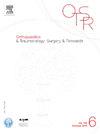机器人辅助全膝关节置换术在外科团队中的学习曲线:115例的前瞻性研究。
IF 2.2
3区 医学
Q2 ORTHOPEDICS
引用次数: 0
摘要
背景:在过去的十年中,机器人辅助已经被强调,以提高TKA对准的准确性。尽管越来越多的人采用机器人辅助全膝关节置换术(raTKA),但人们对个性化对齐技术实现一致结果所需的学习曲线知之甚少。本研究的目的是通过检查手术时间、对准精度、恢复膝关节冠状面对准(CPAK)表型的能力、术后韧带平衡和并发症发生率等因素,评估采用解剖功能植入物定位(AFIP)方法的机器人辅助全膝关节置换术(TKA)学习曲线。本研究解决了以下四个具体的研究问题:1)需要多少病例才能缩短手术时间?2)手术经验是否影响种植体定位精度?3)经验是否影响韧带平衡和CPAK表型恢复?4)经验的增加是否能改善患者报告的结果?假设:我们的假设是随着raTKA使用经验的增加,手术时间会缩短,同时保持种植体定位的高精度。我们进一步假设,根据AFIP协议定义的个性化对齐目标,包括关节线倾角和CPAK表型恢复,可以在早期病例中一致实现,而不会在学习阶段受到损害。患者和方法:在2023年2月至2024年2月期间,共纳入115例使用ROSA机器人工具进行原发性TKA的患者。AFIP技术计划用于每位患者,手术由4名经验丰富的膝关节置换外科医生进行,但之前没有机器人经验。对以下数据进行分析:1)术前、术后全负重面CPAK分型。2)术前和术后韧带平衡,包括在屈伸时评估股胫骨内侧和外侧间隙。3)通过计算术前预期矫正量与术后实现矫正量的差值,确定术后正面对准精度(ΔHip膝关节角(HKA))。此外,记录每位患者的并发症和患者报告的结果测量(PROMs)。采用累积求和法(CUSUM)评价学习曲线的进度。结果:raTKA的实施需要11例患者学习时间才能达到最佳手术时间,平均时间为108分钟。术后对齐在整个系列中保持稳定(ΔHKA = 2.0°±1.0°),不受手术经验的影响。结论:使用AFIP技术的机器人辅助TKA需要很短的学习曲线来优化工作流程,因为11例手术后手术时间得到了改善。重要的是,这个学习阶段不会影响种植体定位的准确性、CPAK和JLO的修复、韧带平衡或患者的安全。证据等级:四级;前瞻性调查,不设对照组。本文章由计算机程序翻译,如有差异,请以英文原文为准。
Learning curve of robotic assisted total knee arthroplasty within a surgical team: A prospective study of 115 cases
Background
Over the last decade, robotic assistance has been highlighted to improve the accuracy of TKA
alignment. Despite growing adoption of robotic-assisted total knee arthroplasty (raTKA), little is known about the learning curve required to achieve consistent outcomes with personalized alignment techniques. The aim of this research was to assess the learning curve of robotic-assisted total knee arthroplasty (TKA) using the anatomic-functional implant positioning (AFIP) method by examining factors such as operative time, alignment accuracy, ability to restore the Coronal Plane Alignment of the Knee (CPAK) phenotype, postoperative ligament balance, and complication rate. This study addressed the following four specific research questions: (1) How many cases are necessary to improve operative time? (2) Does surgical experience affect implant positioning accuracy? (3) Does experience influence ligament balance and CPAK phenotype restoration? (4) Does increased experience improve patient-reported outcomes?
Hypothesis
Our hypothesis was that with increased experience using raTKA, operative time would improve, while maintaining high accuracy of implant positioning. We further hypothesized that personalized alignment targets, as defined by the AFIP protocol, including joint line obliquity and CPAK phenotype restoration, could be consistently achieved from the early cases, without being compromised during the learning phase.
Patients and methods
In total, 115 patients undergoing primary TKA with the ROSA robotic tool were prospectively included between February 2023 and February 2024. The AFIP technique was planned for each patient, and surgeries were performed by 4 experienced knee arthroplasty surgeons but with no prior experience in robotics. The following data were analyzed: (1) Preoperative and postoperative CPAK classification on full weight-bearing views. (2) Pre- and postoperative ligament balance, including the evaluation of medial and lateral femoro-tibial gaps in both flexion and extension. (3) The precision of postoperative frontal alignment (ΔHip Knee Angle (HKA)) was determined by calculating the discrepancy between the intended preoperative correction and the achieved postoperative adjustment. In addition complications and patient‐reported outcome measures (PROMs) were recorded for each patient. Cumulative summation (CUSUM) analysis was employed to evaluate the progression of learning curves.
Results
The implementation of raTKA required a learning period of 11 cases to achieve optimal operative time, with an average duration of 108 min.
Postoperative alignment remained stable throughout the series (ΔHKA = 2.0 ° ± 1.0 °), with no impact from surgical experience. Balanced medial-lateral gaps (defined as <2 mm difference) were achieved in 105 of 115 cases (91%). The CPAK phenotype was restored in 51 of 115 patients (44%), and JLO was successfully restored in 105 of 115 cases (91%). The rate of perioperative complications remained constant (3.5%, n = 4) and was not associated with case sequence (p = 0.89). PROMs improved significantly at 12 months (mean KSS from 57.1 ± 8.3 to 84.9 ± 9.2 [p < 0.001]).
Conclusion
Robotic-assisted TKA using the AFIP technique requires a short learning curve to optimize workflow, as operative time improves after 11 cases. Importantly, this learning period does not compromise implant positioning accuracy, CPAK and JLO restoration, ligament balance, or patient safety.
Level of evidence
IV; prospective investigation without control group.
求助全文
通过发布文献求助,成功后即可免费获取论文全文。
去求助
来源期刊
CiteScore
5.10
自引率
26.10%
发文量
329
审稿时长
12.5 weeks
期刊介绍:
Orthopaedics & Traumatology: Surgery & Research (OTSR) publishes original scientific work in English related to all domains of orthopaedics. Original articles, Reviews, Technical notes and Concise follow-up of a former OTSR study are published in English in electronic form only and indexed in the main international databases.

 求助内容:
求助内容: 应助结果提醒方式:
应助结果提醒方式:


